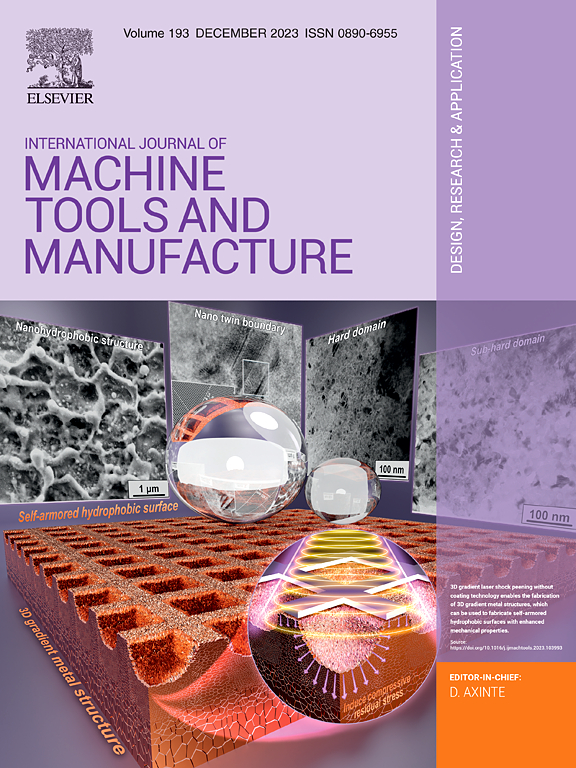在线激光屏蔽电弧定向能量沉积中的氢致孔隙
IF 18.8
1区 工程技术
Q1 ENGINEERING, MANUFACTURING
International Journal of Machine Tools & Manufacture
Pub Date : 2025-04-12
DOI:10.1016/j.ijmachtools.2025.104279
引用次数: 0
摘要
在电弧定向能沉积(arc-DED)中,污染物元素的有害影响,特别是铝合金中的氢致孔隙,对结构完整性提出了严峻的挑战。虽然污染物屏蔽通常用于孔隙抑制,但沉积层反复重熔造成氢污染的风险在很大程度上被忽视了。该研究表明,即使是沉积层上的微量表面氧化物也对氢孔成核起着关键的控制作用。微观结构表征表明,氧化物、氢和孔隙之间存在协同聚类机制,其中氧化物作为氢载体和捕集剂的双重功能位点。为了解决这个问题,我们开发了一种创新的在线激光屏蔽增强电弧ded系统,该系统集成了高频纳秒脉冲激光器和电弧等离子体。这种混合方法实现了熔池内的原位氧化物净化,与传统的弧形ded相比,孔隙率降低了98.1%。激光-电弧协同作用增强了屏蔽效率,电弧等离子体使激光诱导的氧化物去除率提高了9.6倍。至关重要的是,该技术破坏了氧化物介导的氢运输途径,同时消除了熔池中的氢捕获效应。在Al-Zn-Mg-Cu合金中,通过最小化变形敏感层间区域的孔隙率,显著提高了延展性。在Al-Mg合金中进一步验证了工艺的可扩展性,实现了类似的孔隙率降低。通过将氧化物在氢载体和捕集剂中的双重作用解耦,该研究为弧形ded的孔隙控制建立了一种范式转换策略,为加工具有增强机械性能的氢/氧敏感金属提供了一个通用平台。本文章由计算机程序翻译,如有差异,请以英文原文为准。

On-line laser shielding of hydrogen-induced pores in arc-directed energy deposition
The detrimental effects of pollutant elements in arc-directed energy deposition (arc-DED), particularly hydrogen-induced porosity in aluminum alloys, pose critical challenges for structural integrity. While pollutant shielding is commonly employed for pore suppression, the risk of hydrogen contamination from repeated remelting of deposited layers remains largely overlooked. This study revealed that even trace surface oxides on deposited layers critically governed hydrogen pore nucleation. Microstructural characterization demonstrated a synergistic clustering mechanism among oxides, hydrogen, and pores, where oxides act as dual-functional sites for hydrogen carriers and trappers. To address this, we developed an innovative on-line laser shielding-enhanced arc-DED system integrating a high-frequency nanosecond pulsed laser with arc plasma. This hybrid approach achieved in situ oxide purification within the molten pool, reducing porosity by 98.1 % compared to conventional arc-DED. The laser-arc synergy demonstrated amplified shielding efficiency, with the arc plasma enhancing laser-induced oxide removal rate by 9.6 times. Crucially, this technology disrupted the oxide-mediated hydrogen transportation pathway while eliminating hydrogen-trapping effects in the molten pool. Implementation in Al-Zn-Mg-Cu alloys significantly improves ductility by minimizing porosity at deformation-sensitive interlayer regions. Process scalability was further verified in Al-Mg alloys, achieving comparable porosity reduction. By decoupling the dual roles of oxides in hydrogen carriers and trappers, this work establishes a paradigm-shifting strategy for pore control in arc-DED, offering a versatile platform for processing hydrogen/oxygen-sensitive metals with enhanced mechanical performance.
求助全文
通过发布文献求助,成功后即可免费获取论文全文。
去求助
来源期刊
CiteScore
25.70
自引率
10.00%
发文量
66
审稿时长
18 days
期刊介绍:
The International Journal of Machine Tools and Manufacture is dedicated to advancing scientific comprehension of the fundamental mechanics involved in processes and machines utilized in the manufacturing of engineering components. While the primary focus is on metals, the journal also explores applications in composites, ceramics, and other structural or functional materials. The coverage includes a diverse range of topics:
- Essential mechanics of processes involving material removal, accretion, and deformation, encompassing solid, semi-solid, or particulate forms.
- Significant scientific advancements in existing or new processes and machines.
- In-depth characterization of workpiece materials (structure/surfaces) through advanced techniques (e.g., SEM, EDS, TEM, EBSD, AES, Raman spectroscopy) to unveil new phenomenological aspects governing manufacturing processes.
- Tool design, utilization, and comprehensive studies of failure mechanisms.
- Innovative concepts of machine tools, fixtures, and tool holders supported by modeling and demonstrations relevant to manufacturing processes within the journal's scope.
- Novel scientific contributions exploring interactions between the machine tool, control system, software design, and processes.
- Studies elucidating specific mechanisms governing niche processes (e.g., ultra-high precision, nano/atomic level manufacturing with either mechanical or non-mechanical "tools").
- Innovative approaches, underpinned by thorough scientific analysis, addressing emerging or breakthrough processes (e.g., bio-inspired manufacturing) and/or applications (e.g., ultra-high precision optics).

 求助内容:
求助内容: 应助结果提醒方式:
应助结果提醒方式:


